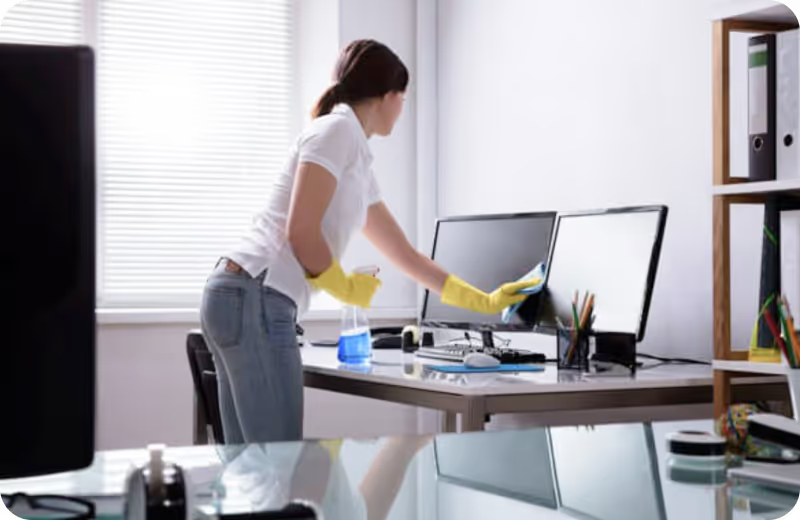
Humidifiers are beneficial to have around the office where the air might be too dry. The vapors emitted from humidifiers may prevent dry skin, cracked lips, and respiratory conditions brought about by dry air, according to the Mayo Clinic.
However, the standing water left in humidifiers may be harmful as mold and bacteria growth can send off spores that may cause allergies and other respiratory problems. Stagnant water may also give off an unpleasant smell, which would be off-putting in a closed environment such as an office or commercial space.
In this article, we'll provide step by step instructions on the right way in disinfecting your humidifier. There are several types of humidifiers, but we'll focus on the standard, standalone unit that is not built into the central air conditioning system.
What You’ll Need
- Distilled white vinegar
- Baking soda
- Rubbing alcohol OR Liquid chlorine bleach OR Hydrogen peroxide
- Towels or paper towels
- Soft bristled brush
How to Disinfect Humidifier
Step 1: Dismantle the Humidifier
First, dismantle the humidifier by removing the water tank from the rest of the unit. Make sure the unit is turned off and unplugged to avoid accidental electrocution. Remove the air filter as well if your unit has one. Dismantle all removable parts whenever possible, so you can get a thorough cleaning.
Step 2: Create a Vinegar and Baking Soda Solution
Create a powerful cleaning solution with vinegar and baking soda. Mix together 1 cup of white vinegar, 1 cup of warm water, and 1/2 a cup of baking soda in a bottle. Mix or shake well to incorporate the ingredients together. This liquid solution will be used to clean the humidifier tank, as well as any removable part.
Create a thicker cleaning solution with baking soda, and just enough white vinegar to create a paste. This paste can be used in various areas that cannot be submerged in water, like the base and the mechanical components.
Step 3: Scrub with a Soft Brush
Take the baking soda paste you've just made, and use a cleaning brush to apply the paste onto the nooks and crannies of the base. The paste should be dry enough not to damage the unit. Allow the baking soda paste to sit for at least 10 minutes before scrubbing with a cleaning brush. Wipe dry to remove any residue.
Use the same cleaning paste to remove any mold and mildew stains from the removable parts as well. Place the paste directly on stained areas on the tank cap, filter, or output nozzle in both cool mist and warm mist humidifiers, which are susceptible to mold.
Also read: How to Disinfect Your Mobile Phone
Step 4: Clean the Water Tank
Pour the liquid vinegar solution directly into the tank. Swirl the solution around to ensure each area is covered in a good layer of the cleaning solution. Let the solution sit for 20-30 minutes to allow the vinegar solution to remove the hard water stains formed by regular use.
After soaking, it is a good idea to use your cleaning brush to gently lift away any stains and dirt from the tank. This will keep your humidifier clean longer as you remove the source of the stains. Vinegar and baking soda are great for removing mold and mildew growths, including the stains they leave behind!
Step 5: Rinse and Disinfect
After you clean a humidifier with vinegar, completely rinse away any vinegar residue to prepare the tank for disinfection. Vinegar is known to react negatively to a myriad of cleaners, so be sure your tank is completely void of vinegar before you disinfect it.
Use rubbing alcohol, hydrogen peroxide, or a diluted bleach solution to clean a humidifier tank. Fill the tank with your preferred disinfecting solution, and swirl it around to ensure each area gets a deeper clean. Let the disinfectant sit for at least 10 minutes to kill off any lingering bacteria. Use fresh water to rinse the tank afterwards, but this step is optional.
Don't forget to disinfect the base by wiping it with your preferred disinfectant. Soak all waterproof parts in disinfecting solution as well, including the wick filter. Take a cotton bud dipped in disinfectant to clean small areas like the spout where water vapor comes out for a thorough, deep clean.
Step 6: Allow to Air Dry
Allow all the parts to dry before placing the parts back together. You can opt to leave it in a drafty area to dry, or wipe each part dry before you place the unit back together. When you clean a humidifier, you remove the traces of mold and bacteria on it. Keeping the unit dry for storage helps prevent the nasty microbes from forming again.
How Often Do You Have to Clean a Humidifier?
With regular cleaning, a humidifier should provide you with clean vapor that introduces a healthy amount of moisture into the air. The frequency in which you need to clean your humidifier depends on how often you use it. The more you use your humidifier, the more often you need to clean it.
A good schedule is to clean the humidifier once a week, which will prevent mold and bacteria from growing exponentially. If you don't use the humidifier that often, you can opt to clean it once every two weeks, but make sure you dump out the remaining water from the tank and dry the unit thoroughly before storing it.
Check out our blog for more articles on office cleaning!





























